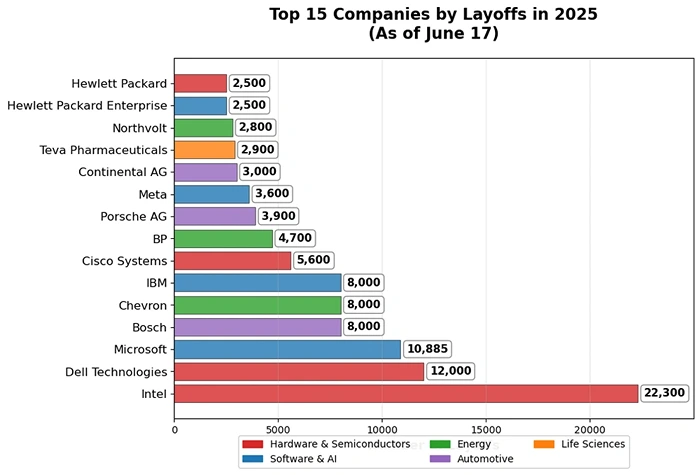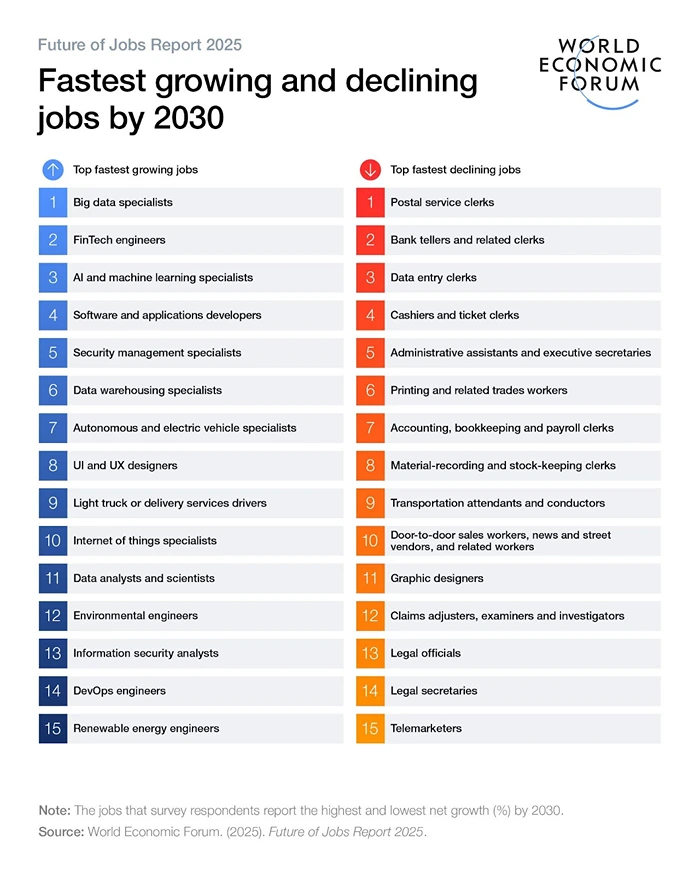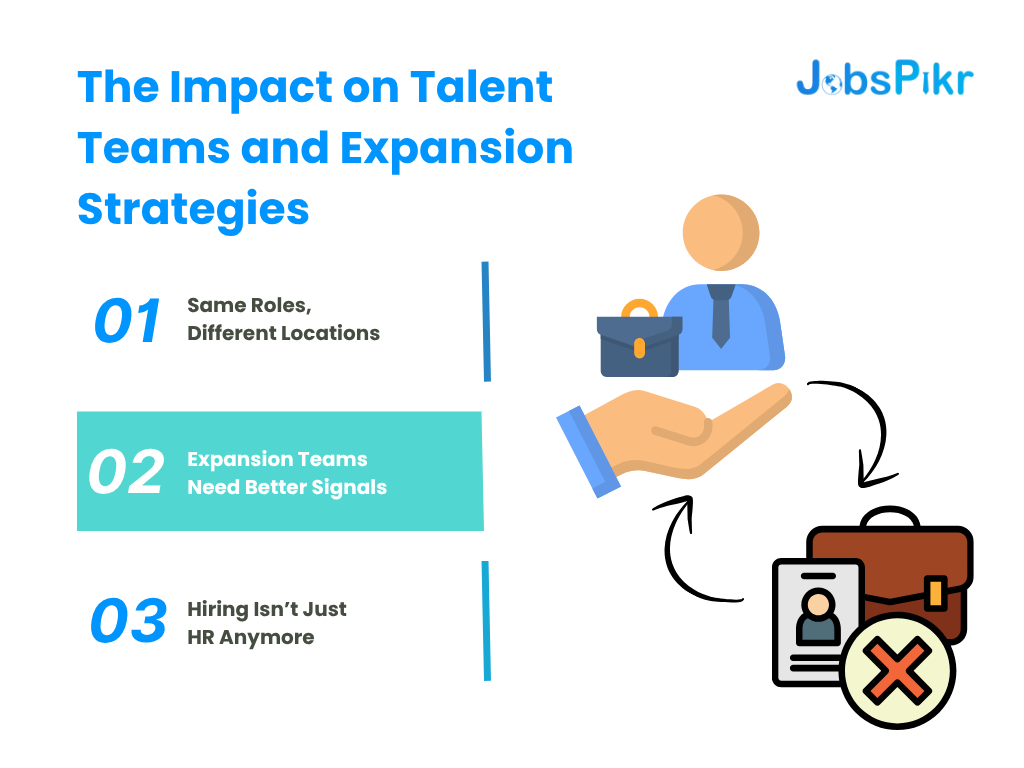- Why Job Data Today Matters More Than Ever
- Rising Layoffs: A Snapshot of the Global Employment Landscape
- Job Openings Amid the Chaos: Where Opportunities Are Still Growing
- Roles in Demand: How Talent Needs Are Shifting Across Borders
- The Impact on Talent Teams and Expansion Strategies
- Why Real-Time Job Market Data Is a Strategic Necessity
- How JobsPikr Can Help Decode Labor Market Analytics
- The New Normal for Global Hiring
- FAQs
Why Job Data Today Matters More Than Ever
It’s a weird time for jobs right now. You’ve probably noticed it, one minute, you’re seeing news about huge layoffs at companies you thought were doing great. The next minute, you hear about record hiring in some completely different sector. It’s hard to keep up.
The truth is, the job market doesn’t move in one direction anymore. It’s all over the place. That’s why knowing what the job data today says is so important. Not what happened last quarter or last year, but what’s happening right now.
If you’re running a global team, trying to figure out where to grow next, or even just watching the market, guessing won’t get you far. You need fresh job market data, real signals from different countries and industries. That’s where tools like JobsPikr come in. They help make sense of it all, what’s changing, where demand is rising, and what roles are taking off.
Because right now? You don’t just need good instincts. You need good labor market analytics to back them up.
Rising Layoffs: A Snapshot of the Global Employment Landscape

Image Source: R&DWorld
It’s been a tough year so far for workers around the world. Every week, there’s another announcement, and thousands of people suddenly out of a job. You don’t even need to follow the news that closely to feel it. Tech firms, banks, big-box retailers, and even some logistics and media companies they’re all trimming down.
In the U.S. alone, over 257,000 workers were laid off in the first four months of 2025, based on data from Challenger, Gray & Christmas. That’s already higher than all of 2023. And it’s not just Silicon Valley anymore. Financial firms, healthcare companies, and even AI startups are starting to pull back.
Across the Atlantic, things aren’t much better. In the UK, redundancies rose by 44% in Q1 compared to last year, according to the Office for National Statistics. Over in Germany, several major automakers have scaled back production, and with it, thousands of jobs have quietly disappeared. In Asia, companies in India’s tech and startup ecosystem have laid off over 35,000 people since January, many of them in roles that were considered “safe” just a year ago.
You’d expect all this to show up in unemployment numbers right away, but oddly, that hasn’t happened across the board. In fact, the U.S. unemployment rate in April 2025 was still sitting at 3.9%, which isn’t far off from what economists consider “full employment.” So what’s going on?
Here’s the strange truth: while a lot of big names are slashing headcount, others, especially smaller firms and companies in different sectors, are still hiring. Even in the middle of all this noise, there were nearly 8.5 million job openings in the U.S. as of April, based on the Bureau of Labor Statistics. Some industries are bleeding jobs, but others are soaking them up just as fast.
This is where it gets messy. You can’t just look at layoffs in isolation. What matters is the full picture. Who’s hiring? Where? What kinds of roles? You won’t find those answers by just reading headlines. You need fresh, accurate job market data from multiple regions to really understand what’s going on.
Because when you zoom out, it’s not a single job market. It’s a bunch of overlapping ones, some shrinking, some expanding. And if you’re trying to hire or grow globally, you can’t afford to look at just one piece of the puzzle. You need to look at the whole map.
Sources:
- Challenger, Gray & Christmas, U.S. Layoffs Report (Q1 2025)
- Bureau of Labor Statistics, Job Openings and Labor Turnover Survey (April 2025)
- Office for National Statistics, UK Labour Market Overview (Q1 2025)
- Inc42, Indian Tech Layoffs Tracker (2025)
Job Openings Amid the Chaos: Where Opportunities Are Still Growing
Lately, it’s all layoffs in the news. It makes sense—big numbers grab attention. But that’s not the full picture. Even as companies cut jobs, others are posting new ones. And not just here and there. In some places, hiring is still going strong. You just don’t hear about it as much.

Image Source: World Economic Forum
Healthcare’s Still Scrambling to Fill Roles
Even with everything going on, hospitals and clinics haven’t slowed down. If anything, they’re short on people. Nurses, lab staff, and mental health support workers, still in demand. In April alone, over 13% of all U.S. job postings were in healthcare. That’s not a small number, and it hasn’t dropped much despite all the noise elsewhere.
Manufacturing’s Changed, And It’s Hiring
Now, manufacturing gets ignored a lot, but it’s quietly making a comeback. Not the old-school factory jobs you might picture. It’s more specialized now, EV components, high-precision parts, stuff for clean energy. In Mexico, for instance, job boards show a real uptick in postings for engineers and quality assurance folks. Same with Vietnam. It’s all tied to companies shifting production closer to home or to places with fewer restrictions.
Not All of Tech Is Shrinking
Sure, a lot of tech firms are cutting back. But not all of them. Startups focused on AI, cybersecurity, and cloud infrastructure are doing the opposite—they’re hiring. So you end up with this weird situation: one part of the tech world is freezing, and another is taking off. If you’re only watching the layoffs, you miss what’s growing underneath.
Different Regions, Different Stories
Zoom out a bit, and the global map looks different. In Australia, clean energy companies are posting like crazy. The UAE is seeing more demand in logistics and digital retail. And Poland and Romania? Fast becoming support centers for global tech. There’s no single trend—just a mix of micro-markets doing their own thing.
Why You Might Not Hear About This
The thing is, nobody headlines “Company Hires 200 People.” That’s not news. Layoffs are dramatic. But hiring happens, too, just more quietly. Unless you’re tracking job data today, you probably won’t see it happening. That’s where tools like JobsPikr are useful. They pull in all that messy, live info from around the world and give you something real to go on.
Roles in Demand: How Talent Needs Are Shifting Across Borders
You’d think with all the layoffs going around, nobody would be hiring. But the types of jobs being posted now? They’re changing—and fast. It’s not just about where people are hiring anymore. It’s about what they’re hiring for.
Digital Skills Are Still in the Spotlight
Even with tech layoffs, digital roles haven’t really gone away. They’ve just moved. Companies still need people who understand cloud infrastructure, data privacy, and automation. It’s just that those jobs are no longer clustered in the same places—or with the same companies—as before.
A lot of firms that weren’t even “tech companies” five years ago are now hiring software developers and data analysts. Think retail chains, banks, logistics platforms. They need backend engineers, DevOps, and cybersecurity folks to keep things running smoothly. That’s showing up clearly in job data today across markets.
Green Jobs and Clean Energy Are Picking Up Pace
If there’s one area that seems to be growing no matter what’s going on in the economy, it’s climate-focused work. Wind and solar tech firms are hunting for electrical engineers. Cities are hiring sustainability officers and climate analysts. Even traditional energy companies are suddenly listing roles with “transition” or “net zero” in the title.
In Europe, climate-related jobs have increased by 27% year-over-year, according to a recent LinkedIn Workforce Insights report. And that’s not just public sector stuff—startups and big-name utilities alike are all in.
Demand for Operations, Supply Chain, and Trade Is Holding Strong
While tech roles get most of the attention, some of the most consistent hiring we’re seeing is in logistics and supply chain management. Especially across Southeast Asia and parts of Africa, where trade lanes are shifting and companies are trying to shorten delivery timelines.
You’ll find postings for procurement managers, freight analysts, and warehouse systems leads in cities like Nairobi, Manila, and Ho Chi Minh. It’s not flashy work, but it’s critical, and employers are scrambling to fill those roles.
Support and Customer-Facing Jobs Are Not Going Away
There was a time when people assumed automation would wipe out customer service. That didn’t exactly happen. In fact, with digital platforms expanding, there’s more demand than expected for support specialists who can talk to people and solve problems. Especially those who can handle multiple languages or work across time zones.
So while some back-office roles have gone quiet, customer experience and account management are seeing decent momentum, especially in places like Eastern Europe and South America, where the time difference works for global firms.
The thing to remember here is that job titles might look the same, but what employers are looking for is changing underneath. Sometimes it’s about soft skills. Other times, it’s about adaptability or cross-functional experience. The only way to really spot these shifts is through detailed, real-time job market data—the kind you can’t get from quarterly reports or recycled news coverage.
And when those roles start showing up in new markets? That’s when tools like JobsPikr come in handy. You can track how demand is moving, what skills are being asked for, and where companies are testing new talent pools.
The Impact on Talent Teams and Expansion Strategies
If you’re on a talent team right now, odds are things feel, weird. You’re getting pressure to cut costs, but also to find people in “key markets.” The global job scene used to have a rhythm: you’d hire in Q1, scale in Q3, and pause in Q4. That rhythm’s gone. And in its place? A whole lot of uncertainty.

Same Roles, Different Locations
Let’s say you’re looking for DevOps talent. A few years ago, you’d automatically start with major cities in the U.S., or maybe Berlin, or Bangalore. Now? Those cities are still active, sure—but companies are increasingly pulling in talent from places like Lagos, Belgrade, or Cebu.
It’s not just about cost anymore. It’s about access. Some cities just have fresher pipelines of skilled workers, or less hiring competition at the moment. That’s the kind of insight that only real-time job data today can show you.
Expansion Teams Need Better Signals
For companies planning to open a new office or hire in a new region, this environment is tricky. You can’t just look at GDP numbers and population size anymore. You need to know: Are people getting hired there? Are there enough engineers or sales managers in the local pipeline? Are competitors already scooping them up?
Without current labor market analytics, you might end up opening in a “hot” city where the talent pool’s already dry. That happens more than you’d think.
Hiring Isn’t Just HR Anymore
This stuff used to be something the HR team figured out. Now? Strategy teams, investors, and even CFOs are paying attention to job market data. Because where you’re hiring can affect burn rate, product timelines, and even customer experience.
If you’re investing in a company expanding into Southeast Asia, but they don’t have access to real hiring data in that region? That’s a red flag. You can’t afford to guess anymore—not with so many moving parts.
This is where tools like JobsPikr become more than “nice to have.” They become core to how teams make decisions. It’s not about tracking competitors or looking busy—it’s about knowing where the jobs are going, what skills are trending, and which cities or regions actually have hiring momentum.
Why Real-Time Job Market Data Is a Strategic Necessity
Let’s be honest—strategy used to be about long-term plans. You’d make projections for the year, maybe two. Now? Things change so fast, those plans are outdated before the quarter ends.
Hiring is part of that chaos. One month, you’re seeing thousands of layoffs. Next, there’s a sudden hiring surge in a market you weren’t even watching. That’s why having real-time job market data isn’t just helpful—it’s kind of essential.
Old Data Can’t Tell You What’s Happening Now
By the time traditional labor reports come out, the situation on the ground has already shifted. You might be looking at a report from Q1 that doesn’t reflect the spike in demand for AI engineers that started in mid-April. Or maybe a city that looked stable is suddenly flooded with job seekers because of a local layoff wave. Static reports can’t keep up with that.
This is where real-time job data today makes the difference. When you can see which roles are being posted every day and where, you’re not guessing anymore. You’re responding.
It’s Not Just About Hiring, It’s About Staying Competitive
Let’s say your competitor starts quietly hiring in Colombia. You don’t notice, and six months later, they’ve built a 40-person team for half the cost of your European office. Now they’re faster to market, and their margins look better. That kind of move happens all the time, and the companies paying attention to labor market analytics are the ones spotting those patterns early.
The flip side? If you’re not watching the data, you’re reacting late. And in this market, late usually means expensive.
Talent Insights Aren’t a Nice Bonus—They’re a Core Input
In a world where roles evolve monthly and talent moves across borders, you need to know not just where the jobs are, but what skills are rising, what titles are fading, and which cities are turning into surprise hotspots. That’s the kind of detail that only deep talent insights can give you.
If you’re a business leader or investor, this kind of info isn’t just interesting. It shapes where you spend, where you grow, and who you hire next.
So yeah—spreadsheets and annual forecasts are nice. But if you’re not plugged into what’s happening right now, you’re flying blind. Tools like JobsPikr exist to fix that. They cut through the noise and let you see the real shape of the global hiring landscape.
How JobsPikr Can Help Decode Labor Market Analytics
Alright, so let’s say you’re trying to make sense of all this—layoffs, weird hiring patterns, roles shifting by the month. What do you do with that? You could pull reports from ten different places, read news articles, maybe even scroll through LinkedIn jobs manually. But honestly? That’s going to take forever. And it still might not tell you what’s actually going on.
That’s where JobsPikr comes in.

It’s Built to Show You the Real Hiring Landscape, Not Just Headlines
JobsPikr collects live job data from across countries, sectors, and companies. Not a monthly average. Not a recycled news story. Actual job listings, scraped and structured so you can see what roles are being posted, where they’re popping up, and how fast demand is rising or falling.
Say you want to know how many companies in Southeast Asia are hiring cloud engineers this week, not last quarter. Or maybe you’re tracking whether demand for logistics managers is rising in Tier-2 European cities. This isn’t the kind of stuff you can guess at. It’s right there in the live feed.
Designed for Global Teams, Not Just Recruiters
What makes JobsPikr different is that it’s not just for HR. It’s built for anyone trying to understand workforce trends, talent acquisition leads, business strategists, and even investors who want to see where the hiring heat maps are moving.
There’s a big difference between saying, “We think this market might be interesting,” and being able to say, “Here’s the data showing exactly where job demand is shifting and why.”
Find Signals Before Everyone Else Does
Maybe your competitor is hiring aggressively in a market you hadn’t considered. Or maybe there’s a new kind of job title popping up that hints at a change in how companies are organizing their teams. This stuff doesn’t show up in reports until much later. But with real-time job market data, you can catch it early.
JobsPikr gives you that edge, not just to react faster, but to make smarter decisions about where to build, where to scale back, and where to explore.
It’s not about tracking job posts for fun. It’s about seeing the shape of the global workforce as it shifts. And right now, with everything moving this fast, being able to read that landscape in real time might be the most valuable input you have.
The New Normal for Global Hiring
So what now? We’re clearly not in the hiring landscape we were a few years ago. Layoffs keep making the news, but behind the scenes, jobs are still being created—in new places, in different roles, at companies you might not expect. It’s not about boom or bust anymore. It’s about fragmentation. One part of the world is freezing, and another is hiring like crazy.
That means teams that used to rely on instinct or old trends can’t do that anymore. Gut feeling doesn’t work when the ground keeps shifting. Expansion teams, recruiters, investors—they all need better signals. And those signals live in job data today. Not last month. Not last quarter. Today.
That’s why real-time job market data matters so much now. Because it’s the only way to see what’s changing—who’s hiring, what skills are rising, and where the real opportunities are starting to form. Without it, you’re flying blind.
The truth is, we’re in a new normal. One where there isn’t one global job market, but a bunch of smaller, moving ones. To stay ahead of it all, you don’t need more reports. You need better vision. And that starts with the right data.
Sign up to JobsPikr today!
FAQs
1. Why is everyone talking about layoffs when some companies are still hiring?
Honestly? Because layoffs sound dramatic and they get clicks. But the job market isn’t just one big thing. While some industries are cutting back, others are still hiring like nothing’s changed. You don’t always see that in headlines, but if you’re looking at live job data today, it’s clear. Jobs haven’t vanished—they’ve just shifted to different places and roles.
2. How do I know which countries still have strong job growth?
You won’t figure that out just by reading the news. You’ve got to look at actual job market data—what roles are being posted, how often, and where. Some countries look quiet from the outside, but when you dig into the numbers, hiring’s going strong. That’s the kind of thing you only catch if you’ve got access to what’s happening right now, not what happened last quarter.
3. What roles are actually in demand right now?
That really depends on where you’re looking, but there’s still a lot of movement. I’ve seen growing demand for AI engineers, people in climate tech, logistics managers—you name it. It’s not just tech. Some of the busiest job boards right now are in manufacturing and healthcare. If you’re watching job data today, you can actually see those shifts happening in real time.
4. Why should expansion teams or investors care about labor market analytics?
Because if you’re putting money into a new region, or trying to grow there, you need to know what kind of talent is actually available. Not just what people say—what the data shows. Labor market analytics helps spot real trends early. If the talent pool isn’t there, or if every competitor is already hiring in that spot, you might want to rethink your strategy before it costs you more.
5. What makes JobsPikr different from other tools?
Most tools give you data that’s already a few weeks or months old. But by then, the opportunity might’ve passed. What I like about JobsPikr is that it gives you live job listings, updated constantly. You’re not working off old trends—you’re seeing what’s moving today. That’s a big deal when the market changes this fast.




